Yushun Dong
Intellectual Property in Graph-Based Machine Learning as a Service: Attacks and Defenses
Aug 27, 2025Abstract:Graph-structured data, which captures non-Euclidean relationships and interactions between entities, is growing in scale and complexity. As a result, training state-of-the-art graph machine learning (GML) models have become increasingly resource-intensive, turning these models and data into invaluable Intellectual Property (IP). To address the resource-intensive nature of model training, graph-based Machine-Learning-as-a-Service (GMLaaS) has emerged as an efficient solution by leveraging third-party cloud services for model development and management. However, deploying such models in GMLaaS also exposes them to potential threats from attackers. Specifically, while the APIs within a GMLaaS system provide interfaces for users to query the model and receive outputs, they also allow attackers to exploit and steal model functionalities or sensitive training data, posing severe threats to the safety of these GML models and the underlying graph data. To address these challenges, this survey systematically introduces the first taxonomy of threats and defenses at the level of both GML model and graph-structured data. Such a tailored taxonomy facilitates an in-depth understanding of GML IP protection. Furthermore, we present a systematic evaluation framework to assess the effectiveness of IP protection methods, introduce a curated set of benchmark datasets across various domains, and discuss their application scopes and future challenges. Finally, we establish an open-sourced versatile library named PyGIP, which evaluates various attack and defense techniques in GMLaaS scenarios and facilitates the implementation of existing benchmark methods. The library resource can be accessed at: https://labrai.github.io/PyGIP. We believe this survey will play a fundamental role in intellectual property protection for GML and provide practical recipes for the GML community.
Learning from Diverse Reasoning Paths with Routing and Collaboration
Aug 23, 2025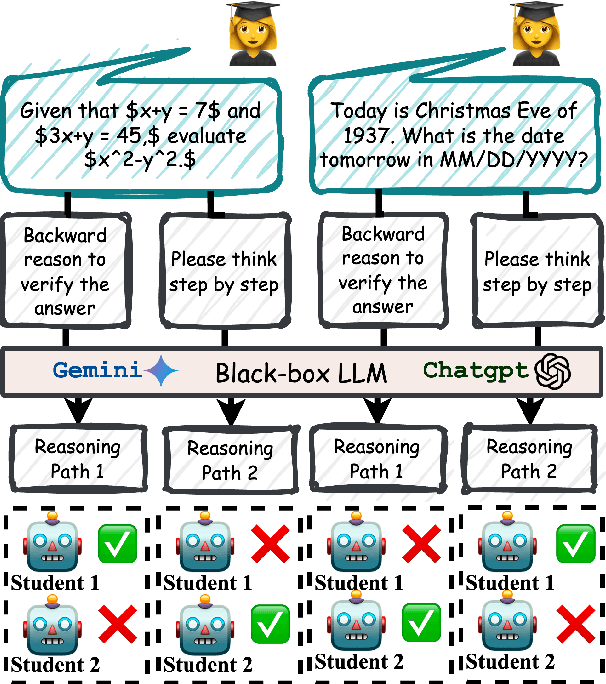
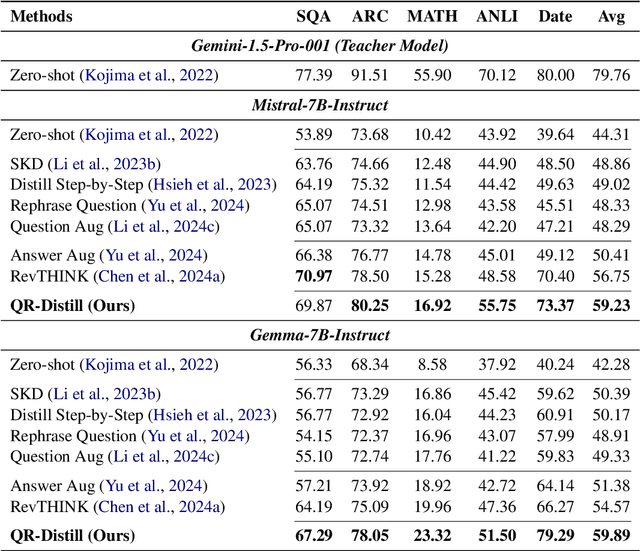
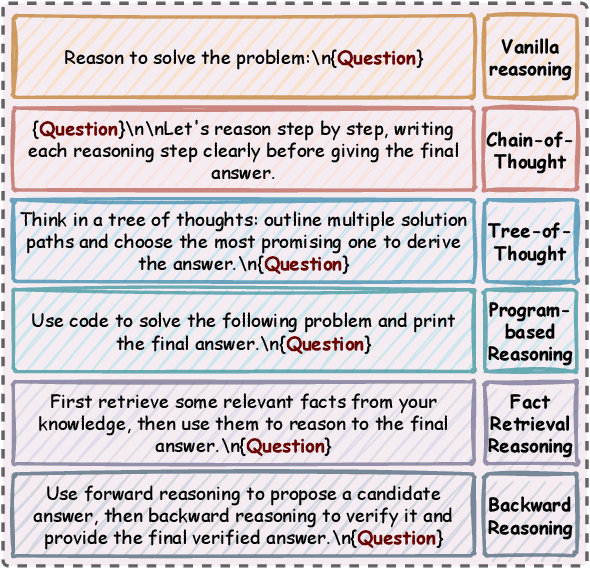
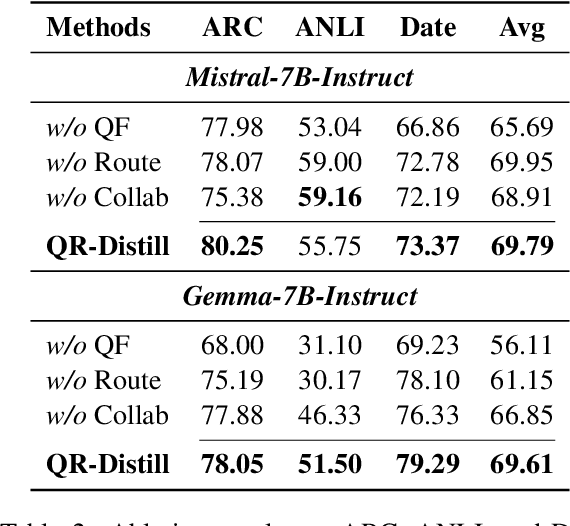
Abstract:Advances in large language models (LLMs) significantly enhance reasoning capabilities but their deployment is restricted in resource-constrained scenarios. Knowledge distillation addresses this by transferring knowledge from powerful teacher models to compact and transparent students. However, effectively capturing the teacher's comprehensive reasoning is challenging due to conventional token-level supervision's limited scope. Using multiple reasoning paths per query alleviates this problem, but treating each path identically is suboptimal as paths vary widely in quality and suitability across tasks and models. We propose Quality-filtered Routing with Cooperative Distillation (QR-Distill), combining path quality filtering, conditional routing, and cooperative peer teaching. First, quality filtering retains only correct reasoning paths scored by an LLM-based evaluation. Second, conditional routing dynamically assigns paths tailored to each student's current learning state. Finally, cooperative peer teaching enables students to mutually distill diverse insights, addressing knowledge gaps and biases toward specific reasoning styles. Experiments demonstrate QR-Distill's superiority over traditional single- and multi-path distillation methods. Ablation studies further highlight the importance of each component including quality filtering, conditional routing, and peer teaching in effective knowledge transfer. Our code is available at https://github.com/LzyFischer/Distill.
A Systematic Survey of Model Extraction Attacks and Defenses: State-of-the-Art and Perspectives
Aug 20, 2025Abstract:Machine learning (ML) models have significantly grown in complexity and utility, driving advances across multiple domains. However, substantial computational resources and specialized expertise have historically restricted their wide adoption. Machine-Learning-as-a-Service (MLaaS) platforms have addressed these barriers by providing scalable, convenient, and affordable access to sophisticated ML models through user-friendly APIs. While this accessibility promotes widespread use of advanced ML capabilities, it also introduces vulnerabilities exploited through Model Extraction Attacks (MEAs). Recent studies have demonstrated that adversaries can systematically replicate a target model's functionality by interacting with publicly exposed interfaces, posing threats to intellectual property, privacy, and system security. In this paper, we offer a comprehensive survey of MEAs and corresponding defense strategies. We propose a novel taxonomy that classifies MEAs according to attack mechanisms, defense approaches, and computing environments. Our analysis covers various attack techniques, evaluates their effectiveness, and highlights challenges faced by existing defenses, particularly the critical trade-off between preserving model utility and ensuring security. We further assess MEAs within different computing paradigms and discuss their technical, ethical, legal, and societal implications, along with promising directions for future research. This systematic survey aims to serve as a valuable reference for researchers, practitioners, and policymakers engaged in AI security and privacy. Additionally, we maintain an online repository continuously updated with related literature at https://github.com/kzhao5/ModelExtractionPapers.
Tracing LLM Reasoning Processes with Strategic Games: A Framework for Planning, Revision, and Resource-Constrained Decision Making
Jun 13, 2025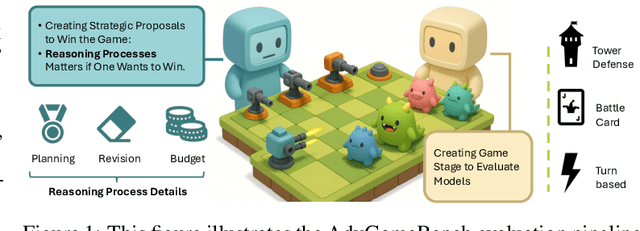


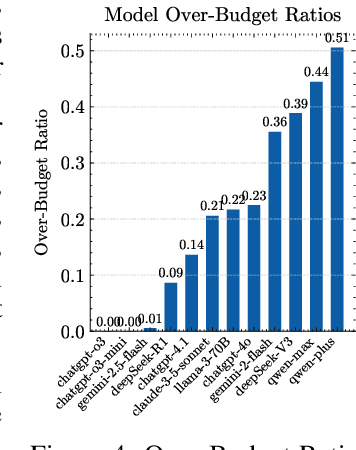
Abstract:Large language models (LLMs) are increasingly used for tasks that require complex reasoning. Most benchmarks focus on final outcomes but overlook the intermediate reasoning steps - such as planning, revision, and decision making under resource constraints. We argue that measuring these internal processes is essential for understanding model behavior and improving reliability. We propose using strategic games as a natural evaluation environment: closed, rule-based systems with clear states, limited resources, and automatic feedback. We introduce a framework that evaluates LLMs along three core dimensions: planning, revision, and resource-constrained decision making. To operationalize this, we define metrics beyond win rate, including overcorrection risk rate, correction success rate, improvement slope, and over-budget ratio. In 4320 adversarial rounds across 12 leading models, ChatGPT-o3-mini achieves the top composite score, with a win rate of 74.7 percent, a correction success rate of 78.6 percent, and an improvement slope of 0.041. By contrast, Qwen-Plus, despite an overcorrection risk rate of 81.6 percent, wins only 25.6 percent of its matches - primarily due to excessive resource use. We also observe a negative correlation between overcorrection risk rate and correction success rate (Pearson r = -0.51, p = 0.093), suggesting that more frequent edits do not always improve outcomes. Our findings highlight the value of assessing not only what LLMs decide but how they arrive at those decisions
GLIP-OOD: Zero-Shot Graph OOD Detection with Foundation Model
Apr 29, 2025Abstract:Out-of-distribution (OOD) detection is critical for ensuring the safety and reliability of machine learning systems, particularly in dynamic and open-world environments. In the vision and text domains, zero-shot OOD detection - which requires no training on in-distribution (ID) data - has made significant progress through the use of large-scale pretrained models such as vision-language models (VLMs) and large language models (LLMs). However, zero-shot OOD detection in graph-structured data remains largely unexplored, primarily due to the challenges posed by complex relational structures and the absence of powerful, large-scale pretrained models for graphs. In this work, we take the first step toward enabling zero-shot graph OOD detection by leveraging a graph foundation model (GFM). We show that, when provided only with class label names, the GFM can perform OOD detection without any node-level supervision - outperforming existing supervised methods across multiple datasets. To address the more practical setting where OOD label names are unavailable, we introduce GLIP-OOD, a novel framework that employs LLMs to generate semantically informative pseudo-OOD labels from unlabeled data. These labels enable the GFM to capture nuanced semantic boundaries between ID and OOD classes and perform fine-grained OOD detection - without requiring any labeled nodes. Our approach is the first to enable node-level graph OOD detection in a fully zero-shot setting, and achieves state-of-the-art performance on four benchmark text-attributed graph datasets.
FedHERO: A Federated Learning Approach for Node Classification Task on Heterophilic Graphs
Apr 29, 2025Abstract:Federated Graph Learning (FGL) empowers clients to collaboratively train Graph neural networks (GNNs) in a distributed manner while preserving data privacy. However, FGL methods usually require that the graph data owned by all clients is homophilic to ensure similar neighbor distribution patterns of nodes. Such an assumption ensures that the learned knowledge is consistent across the local models from all clients. Therefore, these local models can be properly aggregated as a global model without undermining the overall performance. Nevertheless, when the neighbor distribution patterns of nodes vary across different clients (e.g., when clients hold graphs with different levels of heterophily), their local models may gain different and even conflict knowledge from their node-level predictive tasks. Consequently, aggregating these local models usually leads to catastrophic performance deterioration on the global model. To address this challenge, we propose FedHERO, an FGL framework designed to harness and share insights from heterophilic graphs effectively. At the heart of FedHERO is a dual-channel GNN equipped with a structure learner, engineered to discern the structural knowledge encoded in the local graphs. With this specialized component, FedHERO enables the local model for each client to identify and learn patterns that are universally applicable across graphs with different patterns of node neighbor distributions. FedHERO not only enhances the performance of individual client models by leveraging both local and shared structural insights but also sets a new precedent in this field to effectively handle graph data with various node neighbor distribution patterns. We conduct extensive experiments to validate the superior performance of FedHERO against existing alternatives.
Few-Shot Graph Out-of-Distribution Detection with LLMs
Mar 28, 2025Abstract:Existing methods for graph out-of-distribution (OOD) detection typically depend on training graph neural network (GNN) classifiers using a substantial amount of labeled in-distribution (ID) data. However, acquiring high-quality labeled nodes in text-attributed graphs (TAGs) is challenging and costly due to their complex textual and structural characteristics. Large language models (LLMs), known for their powerful zero-shot capabilities in textual tasks, show promise but struggle to naturally capture the critical structural information inherent to TAGs, limiting their direct effectiveness. To address these challenges, we propose LLM-GOOD, a general framework that effectively combines the strengths of LLMs and GNNs to enhance data efficiency in graph OOD detection. Specifically, we first leverage LLMs' strong zero-shot capabilities to filter out likely OOD nodes, significantly reducing the human annotation burden. To minimize the usage and cost of the LLM, we employ it only to annotate a small subset of unlabeled nodes. We then train a lightweight GNN filter using these noisy labels, enabling efficient predictions of ID status for all other unlabeled nodes by leveraging both textual and structural information. After obtaining node embeddings from the GNN filter, we can apply informativeness-based methods to select the most valuable nodes for precise human annotation. Finally, we train the target ID classifier using these accurately annotated ID nodes. Extensive experiments on four real-world TAG datasets demonstrate that LLM-GOOD significantly reduces human annotation costs and outperforms state-of-the-art baselines in terms of both ID classification accuracy and OOD detection performance.
ATOM: A Framework of Detecting Query-Based Model Extraction Attacks for Graph Neural Networks
Mar 20, 2025Abstract:Graph Neural Networks (GNNs) have gained traction in Graph-based Machine Learning as a Service (GMLaaS) platforms, yet they remain vulnerable to graph-based model extraction attacks (MEAs), where adversaries reconstruct surrogate models by querying the victim model. Existing defense mechanisms, such as watermarking and fingerprinting, suffer from poor real-time performance, susceptibility to evasion, or reliance on post-attack verification, making them inadequate for handling the dynamic characteristics of graph-based MEA variants. To address these limitations, we propose ATOM, a novel real-time MEA detection framework tailored for GNNs. ATOM integrates sequential modeling and reinforcement learning to dynamically detect evolving attack patterns, while leveraging $k$-core embedding to capture the structural properties, enhancing detection precision. Furthermore, we provide theoretical analysis to characterize query behaviors and optimize detection strategies. Extensive experiments on multiple real-world datasets demonstrate that ATOM outperforms existing approaches in detection performance, maintaining stable across different time steps, thereby offering a more effective defense mechanism for GMLaaS environments.
ExPath: Towards Explaining Targeted Pathways for Biological Knowledge Bases
Feb 25, 2025Abstract:Biological knowledge bases provide systemically functional pathways of cells or organisms in terms of molecular interaction. However, recognizing more targeted pathways, particularly when incorporating wet-lab experimental data, remains challenging and typically requires downstream biological analyses and expertise. In this paper, we frame this challenge as a solvable graph learning and explaining task and propose a novel pathway inference framework, ExPath, that explicitly integrates experimental data, specifically amino acid sequences (AA-seqs), to classify various graphs (bio-networks) in biological databases. The links (representing pathways) that contribute more to classification can be considered as targeted pathways. Technically, ExPath comprises three components: (1) a large protein language model (pLM) that encodes and embeds AA-seqs into graph, overcoming traditional obstacles in processing AA-seq data, such as BLAST; (2) PathMamba, a hybrid architecture combining graph neural networks (GNNs) with state-space sequence modeling (Mamba) to capture both local interactions and global pathway-level dependencies; and (3) PathExplainer, a subgraph learning module that identifies functionally critical nodes and edges through trainable pathway masks. We also propose ML-oriented biological evaluations and a new metric. The experiments involving 301 bio-networks evaluations demonstrate that pathways inferred by ExPath maintain biological meaningfulness. We will publicly release curated 301 bio-network data soon.
A Survey of Model Extraction Attacks and Defenses in Distributed Computing Environments
Feb 22, 2025Abstract:Model Extraction Attacks (MEAs) threaten modern machine learning systems by enabling adversaries to steal models, exposing intellectual property and training data. With the increasing deployment of machine learning models in distributed computing environments, including cloud, edge, and federated learning settings, each paradigm introduces distinct vulnerabilities and challenges. Without a unified perspective on MEAs across these distributed environments, organizations risk fragmented defenses, inadequate risk assessments, and substantial economic and privacy losses. This survey is motivated by the urgent need to understand how the unique characteristics of cloud, edge, and federated deployments shape attack vectors and defense requirements. We systematically examine the evolution of attack methodologies and defense mechanisms across these environments, demonstrating how environmental factors influence security strategies in critical sectors such as autonomous vehicles, healthcare, and financial services. By synthesizing recent advances in MEAs research and discussing the limitations of current evaluation practices, this survey provides essential insights for developing robust and adaptive defense strategies. Our comprehensive approach highlights the importance of integrating protective measures across the entire distributed computing landscape to ensure the secure deployment of machine learning models.
 Add to Chrome
Add to Chrome Add to Firefox
Add to Firefox Add to Edge
Add to Edge